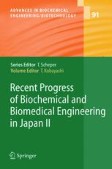Search
Search Results
-
The human Werner Syndrome as a model system for aging
The aging process is one of the most challenging biological pathways to understand. Applications of model systems for aging have contributed...
-
Aging and mitochondrial dysfunction in the filamentous fungus Podospora anserina
In the filamentous fungus Podospora anserina, mitochondria play a paramount role in life span control and aging. During aging, these organelles...
-
Aging and the programmed death phenomena
Biochemical mechanisms of the programmed death phenomena are considered at levels of unicellular organisms, mitochondria, cells, groups of cells, and...
-
Bioprocess Monitoring Using Near-Infrared Spectroscopy
Near-infrared spectroscopy (NIR) is a nondestructive analytical technique that has been used for simultaneous prediction of the concentrations of...
-
Metabolic Flux Analysis Based on 13C-Labeling Experiments and Integration of the Information with Gene and Protein Expression Patterns
The recent progress on metabolic systems engineering was reviewed, in particular focusing on the metabolic flux analysis (MFA) based on the...
-
Introduction: Regulatory processes, an emerging feature in intracellular membrane traffic
The subject of this volume is the molecular mechanism of the intracellular membrane trafficking, a central eukaryotic cell biological process. In the...
-
Regeneration of Articular Cartilage
Loss of articular cartilage from the ends of bones forming diarthrodial joints can be the source of profound pain and disability, and eventually lead...
-
Recent Progress in Microbial Cultivation Techniques
Recent advances in the improvement of microbial cultivation are reviewed, with emphasis on biochemical engineering techniques as a means of obtaining...
-
Transgenic Birds for the Production of Recombinant Proteins
Transgenic birds were expected to be an excellent transgenic bioreactor for the production of recombinant pharmaceutical proteins. However, the only...
-
High Rate Production of Hydrogen/Methane from Various Substrates and Wastes
To treat soluble and solid wastes and recover energy from them, high rate methane fermentation, especially using the UASB (upflow anaerobic sludge...
-
Cell-free Protein Synthesis Systems: Increasing their Performance and Applications
The Escherichia coli cell-free protein synthesis system can now be used for various proteins that need special requirements, such as disulfide bond...
-
Application of Knowledge Information Processing Methods to Biochemical Engineering, Biomedical and Bioinformatics Fields
In biochemical and biomedical engineering fields there are a variety of phenomena with many complex chemical reactions, in which many genes and...
-
Functions of Rab GTPases in organelle biogenesis
Rab GTPases regulate diverse aspects of the biogenesis of secretory and endocytic organelles. The conformational changes that accompany GTP binding...
-
Tissue Engineering Strategies for Bone Regeneration
Bone loss due to trauma or disease is an increasingly serious health problem. Current clinical treatments for critical-sized defects are problematic...
-
Hydrogels for Musculoskeletal Tissue Engineering
The advancements in scaffold-supported cell therapy for musculoskeletal tissue engineering have been truly dramatic in the last couple of decades....
-

-
Energy metabolism, anti-oxidant defense and aging in Caenorhabditis elegans
Food restriction and impaired gene function by mutation or RNAi treatment can extend the lifespan of Caenorhabditis elegans considerably. In contrast...
-
Do green plants age, and if so, how?
Time-dependent ageing-like processes in green plants are discussed and compared to gerontological changes in animals and other organisms. The...
-
Conditional senescence in prokaryotes
Bacteria are immortal in the sense that their capacity for reproduction appears limitless as long as the environment supports growth. However, this...
-
Biopolyesters in Tissue Engineering Applications
Tissue engineering is a rapidly growing interdisciplinary field of research focused on the development of vital autologous tissue through the use...
